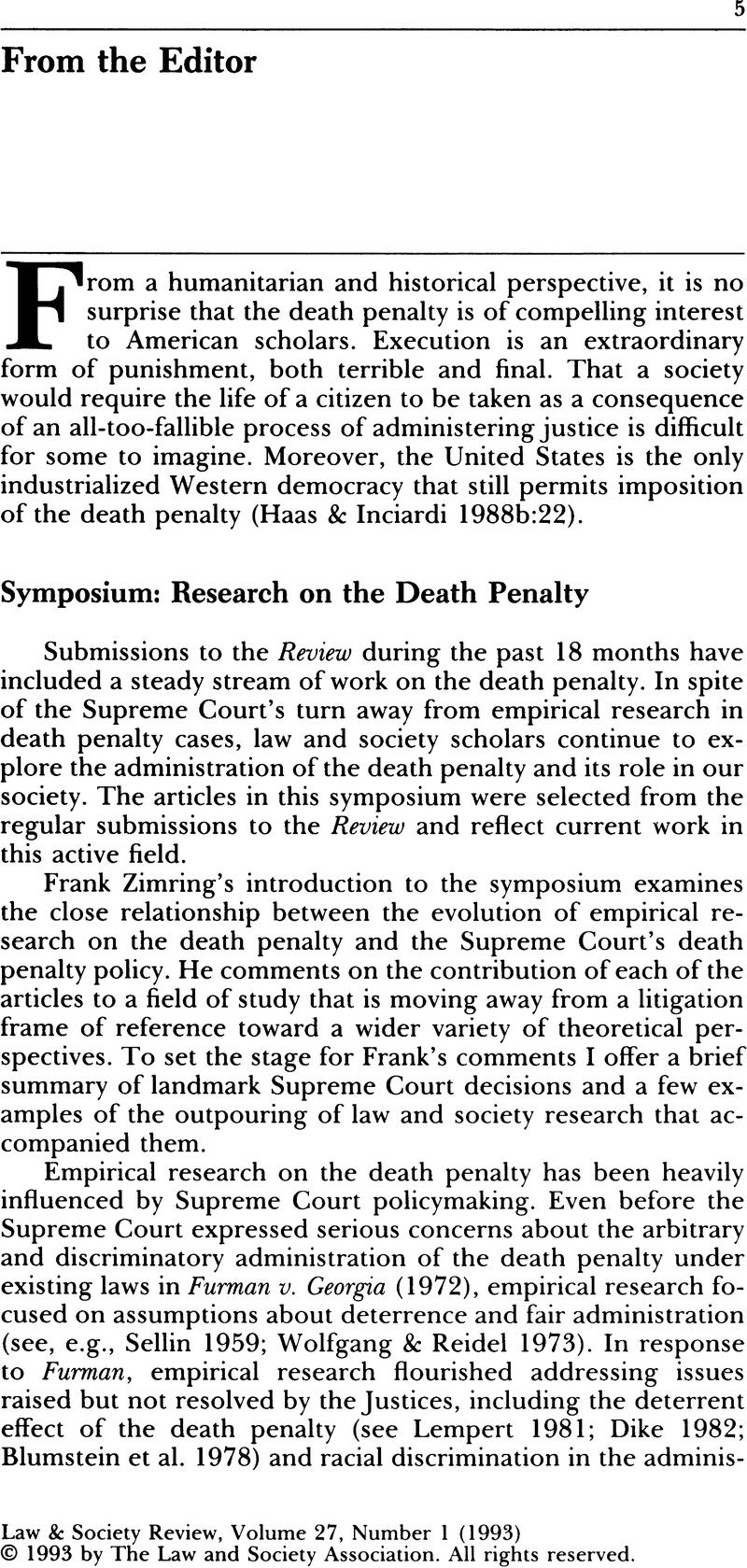No CrossRef data available.
Article contents
From the Editor
Published online by Cambridge University Press: 02 April 2024
Abstract
An abstract is not available for this content so a preview has been provided. As you have access to this content, a full PDF is available via the ‘Save PDF’ action button.

- Type
- Editorial
- Information
- Copyright
- Copyright © 1993 by The Law and Society Association
References
References
Baldus, David C., Pulaski, Charles A., & Woodworth, George (1983) “Comparative Review of Death Sentences: An Empirical Study of the Georgia Experience,” 74 J. of Criminal Law & Criminology 661.Google Scholar
Blumstein, Alfred, Cohen, Jacqueline, & Nagin, Daniel, eds. (1978) Deterrence and Incapacitation: Estimating the Effects of Criminal Sanctions on Crime Rates. Washington, DC: National Academy of Sciences.Google Scholar
Bronson, Edward J. (1980) “Does the Exclusion of Scrupled Jurors in Capital Cases Make the Jury More Likely to Convict? Some Evidence from California,” 3 Woodrow Wilson J. of Law 11.Google Scholar
Cowan, Claudia L., Thompson, William C., & Ellsworth, Phoebe C. (1984) “The Effects of Death Qualification on Jurors' Predisposition to Convict and on the Quality of Deliberation,” 8 Law & Human Behavior 53.Google Scholar
Dike, Sarah T. (1982) Capital Punishment in the U.S.: A Consideration of the Evidence. Hackensack, NJ: National Council on Crime & Delinquency.Google Scholar
Finch, Michael, & Ferraro, Maria (1986) “The Empirical Challenge to Death-qualified Juries: On Further Examination,” 65 Nebraska Law Rev. 21.Google Scholar
Fitzgerald, Robert, & Ellsworth, Phoebe C. (1984) “Due Process vs. Crime Control: Death Qualification and Jury Attitudes,” 8 Law & Human Behavior 31.Google Scholar
Goldberg, Faye (1970) “Toward Expansion of Witherspoon: Capital Scruples, Jury Bias, and Use of Psychological Data to Raise Presumptions in the Law,” 5 Harvard Civil Rights–Civil Liberties Law Rev. 53.Google Scholar
Gross, Samuel R., & Mauro, Robert (1989) Death and Discrimination: Racial Disparities in Capital Sentences. Boston: Northeastern University Press.Google Scholar
Haas, Kenneth C., & Inciardi, James A., eds. (1988a) Challenging Capital Punishment: Legal and Social Science Approaches. Newbury Park, CA: Sage Publications.Google Scholar
Inciardi, James A. (1988b) “Lingering Doubts about a Popular Punishment,” in Haas & Inciardi 1988a: 11–28.Google Scholar
Jacoby, Joseph E., & Paternoster, Raymond (1982) “Sentencing Disparity and Jury Packing: Further Challenges to the Death Penalty,” 73 J. of Criminal Law & Criminology 379.Google Scholar
Lempert, Richard O. (1981) “Desert and Deterrence: An Assessment of the Moral Bases of the Case for Capital Punishment,” 79 Michigan Law Rev. 1177.Google Scholar
Radelet, Michael L. (1981) “Racial Characteristics and the Imposition of the Death Penalty,” 46 American Sociological Rev. 918.Google Scholar
Wolfgang, Marvin E., & Reidel, Marc (1973) “Race, Judicial Discretion and the Death Penalty,” 407 Annals of the American Academy of Political & Social Science 119.Google Scholar


